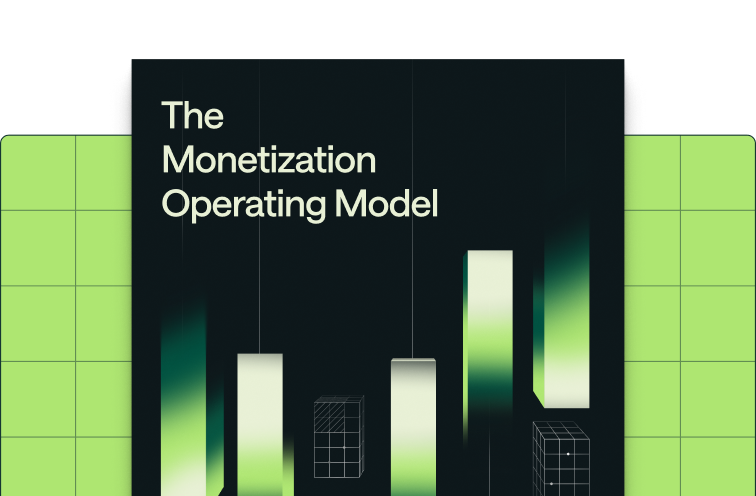Share
Most companies think monetization comes down to a simple choice: seat-based or usage-based pricing. Pick one, build it, done.
But that's not what's actually happening. Look under the hood at any growing software company, and you'll find multiple pricing models running simultaneously.
What appears to be "seat-based pricing" on the website includes hybrid models, grandfather clauses, regional variations, enterprise negotiations, and AI add-ons all operating at once.
This explosion of complexity has turned monetization infrastructure from a back-office necessity into something much more strategic. The companies that master this complexity are pulling away from competitors still managing it through spreadsheets and manual processes.
The complexity explosion: Why pricing models keep multiplying
Software companies can't stick to simple models anymore. Market forces keep pushing them toward more complexity, whether they want it or not.
Product-led and sales-led growth don't play nice
Companies increasingly need both product-led growth (PLG) and sales-led growth (SLG) to compete effectively. The problem? Each motion creates different operational requirements that don't align well.
Self-serve customers want standardized, transparent pricing they can understand immediately. They need predictable costs and will abandon signup flows that don't clearly show what they'll pay. Enterprise buyers also want predictability, but delivered through custom contract terms, volume discounts, and negotiated minimums that reflect their specific usage patterns and procurement requirements.
From a systems perspective, this creates different operational challenges. Self-serve requires managing thousands of customers on standard plans with automated entitlement management, fraud detection, and usage alerting. Enterprise requires handling many custom contracts with unique pricing terms, without manual workarounds every time something changes.
The result is two separate pricing engines for the same product. Teams manage different rate cards, different packaging, and different billing logic for customers who might be using identical features, but with completely different operational overhead.
AI breaks traditional pricing models
AI features are reshaping pricing models, but not by replacing seats entirely. The high variable costs of AI compute force companies to blend subscription and usage models in new ways. Many AI companies now offer seat-based pricing with usage limits or credits included, think Copilot pricing with monthly AI query allowances.
The economics of AI make pure subscription models unsustainable. When a single customer query can cost $0.01 or $1.00 depending on model complexity, companies need pricing that reflects these variable costs while maintaining predictability for customers.
A typical SaaS company adding AI might charge seats for core access, include monthly AI credits per seat, then charge overages for additional usage. Or they might offer usage-based pricing for AI features alongside traditional subscriptions for platform access. Each pricing dimension requires its own cost management, billing logic, and customer communication.
Global expansion creates SKU multiplication
Regional pricing variations, local tax requirements, currency fluctuations, and partner channel discounts multiply SKUs exponentially. A company with 3 plans in the US might have 15 variations across global markets, each with different pricing tiers and billing requirements.
Partner channels add another layer. The same feature might be priced differently through direct sales, reseller channels, and marketplace listings, each requiring separate rate cards and margin calculations.
Enterprise deals break every pricing rule
Large customers negotiate custom terms that create unique pricing for every major deal. Volume discounts, commit-based pricing, custom success metrics, and grandfather clauses mean enterprise contracts rarely match standard rate cards.
Sales teams end up managing pricing exceptions that cascade through billing systems, revenue recognition, and financial reporting. What started as simple pricing becomes a collection of one-off arrangements held together by spreadsheets and manual processes.
{{widget-monetization-whitepaper}}The hidden costs: when complexity cripples growth
This complexity creates massive operational overhead that most companies don't measure or recognize until it's too late.
Engineering teams build billing instead of product
Development teams spend significant time maintaining pricing logic, billing pipelines, and usage tracking systems. Engineers debug pricing edge cases, build custom invoicing workflows, and field late-night support calls about billing disputes.
This isn't just a distraction. B2B monetization complexity now requires dedicated engineering resources that could otherwise build product features that drive growth.
Revenue leaks through manual processes
Spreadsheet overrides, disconnected systems, and manual billing adjustments create constant revenue leakage. Finance teams can't track where money gets lost because pricing logic lives in multiple places with no single source of truth.
Here's what happens when pricing changes break billing systems. A company updates enterprise discount rates in their CPQ tool but forgets to sync the change to their billing system. Six months later, they discover they've been applying the old 15% discount instead of the new 25% to their largest customers. That’s a ton of lost expansion revenue and angry customers who noticed the discrepancy.
The domino effect gets worse when pricing logic lives in multiple systems. Sales quotes a custom rate in Salesforce. Product tracks different usage metrics than what's in the quote. Billing generates invoices based on yet another rate card. When the customer disputes their bill, no one can figure out which system has the "correct" pricing because they all have different versions of the truth.
Billing errors compound over time. A misconfigured rate card or incorrect usage calculation can persist for months before anyone notices, costing companies hundreds of thousands in lost revenue or customer disputes.
Forecasting becomes impossible
GTM leaders can't predict revenue when multiple pricing models run simultaneously. Usage-based customers might spend $100 or $10,000 depending on adoption. Enterprise customers might hit commit minimums or trigger overage pricing based on unpredictable usage patterns.
Traditional forecasting methods break down when pricing varies by customer, contract terms change mid-cycle, and usage patterns shift monthly. Revenue becomes a black box that finance can only understand after the fact.
The strategic opportunity: Complexity as competitive moat
Companies that master monetization complexity gain significant advantages over competitors stuck with simple models.
Better data drives better decisions
AI pricing innovation requires sophisticated pricing approaches that generate better customer data. Companies using hybrid models capture more granular information about how different customer segments create and extract value.
This data enables more targeted pricing decisions, better customer segmentation, and faster identification of expansion opportunities. Companies with simple pricing models miss these insights entirely.
Market responsiveness creates competitive moats
The ability to quickly test new pricing models, respond to competitive moves, and optimize for different customer segments becomes a sustainable advantage. Companies that can launch new SKUs in hours rather than months can capitalize on market opportunities their competitors miss.
Customer feedback loops accelerate when pricing can adapt quickly. A company that can test outcome-based pricing with select customers and iterate based on results will outpace competitors locked into annual pricing reviews.
Customer satisfaction improves with flexibility
Offering pricing that matches how different customers want to buy and use software reduces friction and increases satisfaction. Small teams want predictable monthly costs. Large enterprises want usage-based pricing that scales with value delivery.
Companies that can serve both segments with appropriate pricing models capture more market share and reduce churn compared to those forcing all customers into the same pricing structure.
Framework for mastery: people, process, tools
Successfully managing modern monetization complexity requires coordinated investment across three areas: people, process, and platform.
People: cross-functional monetization teams
Product teams need to define value metrics and usage instrumentation. Finance teams need forecasting accuracy and revenue recognition compliance. Engineering teams need reliable billing infrastructure that doesn't break with pricing changes.
Without clear ownership, pricing changes become cross-functional bottlenecks where every update requires coordination between multiple teams. Companies need someone who owns the monetization system end-to-end, not just individual pieces.
Process: pricing as product development
Pricing changes should follow the same discipline as product development: version control, testing, safe rollbacks, and performance monitoring. Most companies treat pricing updates as one-time projects rather than ongoing product iteration.
A systematic approach includes A/B testing pricing models, progressive rollouts to customer segments, automated monitoring of pricing performance, and rapid iteration based on customer feedback.
Tools: infrastructure that scales with complexity
Usage-based pricing models require sophisticated infrastructure to handle real-time usage tracking, complex billing logic, and customer transparency. Companies can't manage this complexity with basic billing systems designed for subscriptions.
API-driven pricing configuration means business teams can update rates, add new SKUs, or modify billing rules without writing code or filing engineering tickets. Instead of hardcoding pricing logic in multiple places, the system pulls rates from a centralized engine that feeds billing and reporting systems simultaneously.
Real-time usage processing at scale requires handling millions of events per day without latency spikes or data loss. When a customer runs 100,000 AI model calls in an hour, the billing system needs to aggregate usage, apply rate tiers, calculate costs, and update spending dashboards within minutes, not batch processes that run overnight.
The integration challenges are where most companies get stuck. Customer usage data lives in the product. Pricing rules live in CPQ. Billing logic lives in finance systems. Revenue recognition lives in ERPs. Modern systems solve this by maintaining consistent data models across all touchpoints so a single pricing change propagates correctly through every downstream system.
The infrastructure needs include API-driven pricing configuration, real-time usage processing, automated revenue recognition, customer-facing usage dashboards, and integration with CRM and ERP systems.
Companies like OpenAI, Databricks, and Anthropic have turned monetization complexity into a strategic advantage by building purpose-built billing infrastructure that can handle any pricing model without custom development.
The widening gap
Two types of companies are emerging: those that embrace monetization complexity strategically and those drowning in it operationally.
The winners treat pricing as infrastructure. They invest in systems that can handle any pricing model, teams that can iterate quickly, and processes that ensure pricing changes don't break downstream systems. When a competitor launches outcome-based pricing, they can test their own version within days. When a large prospect requests custom usage tiers, they configure and quote them within hours instead of weeks.
The stragglers still manage pricing through spreadsheets, manual processes, and legacy billing systems. They can't experiment with new models because every change breaks something. Their competitors move faster because they're not fighting their own infrastructure. A simple rate change requires engineering sprints, cross-team meetings, and months of testing.
As software becomes more AI-driven, globally distributed, and segment-specific, this gap will only widen. Companies that view complexity as a constraint will fall behind those that turn it into a competitive advantage.
Monetization as strategic infrastructure
Modern monetization complexity isn't going away. If anything, it's accelerating as AI reshapes how software delivers value and customers expect more flexible pricing options.
The companies that will win aren't those that avoid complexity, but those that master it. They'll build systems that turn pricing agility into a growth engine rather than an operational burden.
The choice is clear: invest in monetization infrastructure that scales with complexity, or watch competitors pull ahead while you're still fighting your billing system.
{{widget-monetization-whitepaper}}







%25202%2520(1).png)


